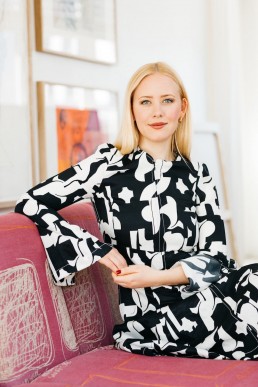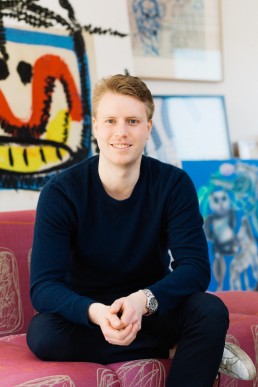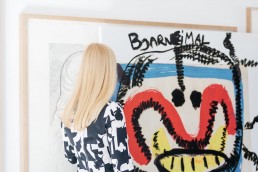“We find it vital to motivate and inspire younger generations to care about and to actively engage in art”
Interview with Tuva Trondsdatter Trønsdal, gallery director of GOLSA
The gallery directors of GOLSA, Gard Eiklid (b. 1991) and Tuva Trondsdatter Trønsdal (b. 1993), might be newcomers on Oslo’s art scene, some would even say outsiders, but they definitely do not lack ambitions. As the new kids on the block, they are not afraid to navigate the art of running a gallery in new ways, the keywords being transparency and education. Or put in their own words: “We usually say that since we don’t know how to run a gallery – we have a bigger chance to do something different!”. Read about how the ambitious Norwegian duo embrace the potential of being rookies in an old, at times stuffy art world in this in-depth interview with Tuva Trondsdatter Trønsdal. This is the story about the transformation of one of Norway’s most prominent galleries.

Initially, GOLSA was opened under the name Rod Bianco in 2009 by artist Bjarne Melgaard. What was the reason for changing the name and what is the difference between Rod Bianco and GOLSA?
Building upon the foundation of the first Rod Bianco opened by Bjarne Melgaard, we reopened the gallery under the same name in 2015 with the aim of exhibiting international contemporary art in Oslo. But after two years, we decided it was time to change the name of the gallery to GOLSA, as we wanted to create our own DNA and focus more on exhibiting a new generation of Norwegian artists. As young founders, it is also important to us to increase the interest and introduce art to a younger audience. We hope to inspire people to experience more art!
What is the story behind your new name, GOLSA?
Our new name, GOLSA, is a traditional Persian girl’s name that we came across during our travel to Iran in 2015, where we had the privilege of visiting the artist Mehdi Ghadyanloo. During our visit, Ghadyanloo’s first daughter – Golsa – was born. In its literal meaning, Golsa means ‘flower-like’, which figuratively translates into ‘beautiful’. The trip to Iran proved to be monumental for the establishment of the gallery, and therefore, we decided to name the gallery GOLSA due to its literal, figurative, and symbolic meanings. Also, since Gard and I visited Iran during Ramadan and managed to survive the heat and lack of food for two weeks, we knew that we could cope with each other at our (probably?) worst. Heat and hunger…

You represent a diverse selection of artists – from established international contemporary artists to young and emerging artists. What do you look for when considering a new artist for your gallery?
I find that it is always a special feeling when finding an artist that I truly like. The feeling is often hard to describe; it must be something about the artist that makes me feel a bit off or confused, mixed with a sense of curiosity. In the end, it is just about wanting to discover more, as well as establishing an interesting dialogue with the artist. We are always looking for new artists and travel far and wide in our search for interesting, talented, and innovative minds. It is important to remember that everything is in movement, including how we are developing as gallerist/curators and as citizens.
We have a group of in-house artists that we represent, continuously follow, and exhibit. However, our goal is also to create a space for experimentation and art that does not normally fit within our regular programme. As such, we participate in a series of projects in which we want to explore the gallery format together with artists, designers, architects, and other creatives. For example, in 2016, we collaborated with the clothing brand HAiK w/ Toril Johannessen and Jacob Riddle and exhibited an installation which included sculptures, video, souvenirs, clothing, and a research publication where everything could be purchased on the spot.
A sentence in your program statement reads: “we are on a mission to educate and share our love for art amongst a younger audience.” How does this reflect in the way you run your gallery and engage with a new generation of art lovers?
We recognize that the threshold is still high for people to come visit galleries, and we find it unfortunate that the industry is still seen as a bit pretentious and intimidating. For us, it is important to communicate that art can be understood and interpreted in different ways, either intellectually, emotionally, or aesthetically. Therefore, we also find it vital to motivate and inspire younger generations to care about and to actively engage in enhancing Oslo’s cultural experience by not just visiting galleries, but also collecting art.
As an example, in August 2018, we hosted Got It For Cheap (GIFC) for the second time, where you can buy original A4 drawings for 30$. We were able to sell 1200 drawings last year, and this year we have 2000 people that has confimed their attendance so far. The aim of GIFC is to make art accessible and to lower the threshold for buying original artwork. Moreover, GIFC creates a platform for young artists to showcase and sell their work to a worldwide audience.
We always try to offer additional ways to make our exhibitions more accessible and to help educate and share our passion for art. Depending on the exhibition, we often host artist talks, readings, panel debates, and/or offer guided tours. In the end, we do not believe that accessibility at all compromises what art can be showcased or the integrity of the art itself.

Do you think that there is a lack of education or basic knowledge about the dynamics of the art market in the art world?
Even within the art world, I think that in order to fully grasp the dynamics of the art market, one must have a particular interest in how the art market functions. The art market functions on many different levels with numerous different players; be it the artists, public or private institutions, auction houses, galleries, dealers, collectors, and all in between. I would not necessarily call it a lack of education or basic knowledge, rather that the art market is for particular people with particular interests. Following the dynamics of the art market is, in my opinion, a lifestyle.
Rather, I would argue that there is a lack of education within the broader culture with respect to art in general, which clearly has an effect on the interest in art within the broader public.
One of the keywords in your philosophy is transparency. How do you seek to foster transparency? Do you show all prices for works for example?
We want to make information about us, our artists, and our activities as transparent as possible in order to make our exhibitions accessible to the broader public. We want to make the art scene more welcoming as opposed to more intimidating, and therefore, for us, transparency is key.
Do you see any particular opportunities or challenges as young gallerists in a, at times, stuffy industry?
As the young newcomers (both born in the 90’s), we are definitely the outsiders that came out of the blue with a big gallery space and with renowned artists from the ‘get go’. We have faced loads of challenges along the way; there are probably many to come, but I think we also have many opportunities and advantages given our situation. We do not necessarily adhere to established norms or ideas within the industry, and as such we remain – perhaps – more open minded than other galleries. We usually say that since we don’t know how to run a gallery, we have a bigger chance to do something different!
In recent years, more and more galleries have abandoned the concept of a physical gallery space by only presenting their artists at fairs or online. GOLSA occupies a space of 500 m2 in the East End of Oslo, Norway. In your eyes, what is the importance of having a physical space and how does it serve your vision?
First and foremost, we both have a passion for contributing to the art scene in Oslo, as we both grew up in the city. Personally, I want GOLSA to be a part of the growing and vibrant art scene in Oslo and contribute in making the city an attractive art destination, both nationally and internationally. Near our gallery space on the East End of Oslo, there are two other great galleries – MELK and STANDARD – and there is room for many more. I enjoy seeing that our audience often takes ‘gallery tours’ and visits the other galleries nearby. Another point is that I thoroughly believe that most art is best experienced first hand – in real life – in a physical space. Why not present artists at fairs, online, AND in a physical space?
How do you experience the current art market and the Norwegian art scene in particularly?
Global art-related investments are on a historical peak, but at the same time there’s never been this many galleries closing down. We can see a similar trend in Norway, with no more galleries today than there was twenty years ago. I hope that we can build an even stronger art scene for the future, if we focus more on art education and on increasing the collaborations between different segments of the art industry. I hope this can include a change of attitude towards how we relate to art in our daily life.

Digitization has widely changed and revitalized the world, including the art world, where more and more digital platforms arise, thus creating new ways for artists, collectors, and gallerists to navigate the art scene, but it also creates new challenges. How does digitalization affect the dynamic of your business?
The biggest and most positive change is that art is now available everywhere, always, for everyone. This might also be a huge challenge since it’s easier to see a show online than to actually visit the space. Another challenge is what we call Instagram friendly art, works that’s made to look good on a screen. There is not necessarily a correlation between the amount of followers and sales and eventually whether it is interesting in an art historical point of view.
Art fairs have been sprouting across the globe the past decade causing the industry to talk about a global fair fatigue. What role do the art fairs play for you as a gallerist and where do you see the future of the art fair is heading?
Fairs have been the most important sales platform for a lot of galleries the past years, but last year, we saw more galleries dropping out, since it’s not financially viable for the galleries or their artists. We still believe in the smaller local fairs. Like Chart that has a unique collection of galleries you will not find in any other fair, focusing only on Scandinavian galleries.
And how about the future of GOLSA? What are your wishes for the gallery and its visitors?
Today Golsa’s program is followed by several fellow Norwegians that are into contemporary art. We want to further develop this positive artistic impact both nationally and internationally – and to inspire and hopefully enlighten more new art collectors. Furthermore, our ambition is that our artists are going to keep on being relevant in the decades to come. Golsa will continue exhibiting emerging and established artists that are touching upon and raising fundamental questions about our society and our lives as human beings!
GOLSA
Waldemar Thranes gate 84C
0175 Oslo
Norway
Opening hours
Wednesday—Friday: 12.00—17.00
Saturday—Sunday: 12:00—16.00
+47 997 87 475
info@golsa.no
Read more here.
Get your free copy of Artland Magazine
More than 60 pages interviews with insightful collectors.